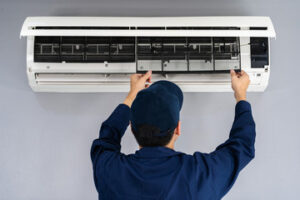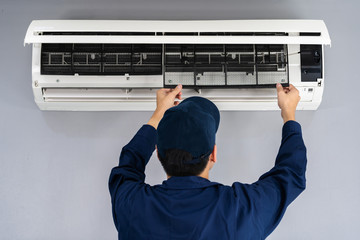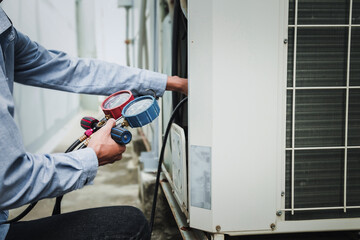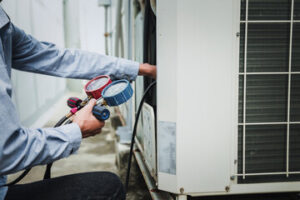Choosing the right HVAC system is a complex process that considers various factors, including climate, home size, and energy efficiency. Getting up to speed on the basics can help homeowners feel more confident in their selection process.
HVAC systems transport air through return vents into the equipment for conditioning and through supply vents into living spaces. They can also offer zoning capabilities that allow different rooms to maintain their own temperature settings. Contact HVAC Round Rock for professional help.
In the HVAC industry, Carrier is renowned for its advanced technology and high efficiency systems. Their Infinity series with Greenspeed Intelligence offers best-in-class energy savings and quiet operation. They adjust to your home’s needs in real time and keep your system running at peak performance all year round. Infinity models also include Wi-Fi capabilities, which allow you to control your system from anywhere. This feature is particularly useful in the winter, when it helps to remove excess humidity from the air.
Both brands offer a wide range of air conditioners and heating units, from basic to premium models. They both prioritize durability and reliability, and their products are backed by a long history of innovation. However, Rheem and Carrier have different strengths that may appeal to homeowners.
While both Carrier and Rheem provide a high level of performance, Carrier is the better choice for homeowners who prioritize energy efficiency and sustainability. They offer a variety of environmentally friendly and high-efficiency systems that can qualify for tax credits and rebates. In addition, they produce systems in the United States and prioritize customer satisfaction.
Whether you are looking for a new central air system or a ductless mini-split, the company has a solution to meet your needs and budget. Their high-efficiency units can reduce your energy costs by up to 50%. They also use a blend of non-ozone-depleting refrigerant, which protects the environment and a homeowner’s health.
Carrier has 39 research and design centers worldwide, which help them create quality systems that are backed by warranties and performance guarantees. The company’s premium products feature innovative features such as variable-speed technology and smart thermostat integration. They are also designed to be as quiet as possible, reducing noise pollution in the home.
Carrier’s high-efficiency heat pumps are rated up to 23 SEER and 14 HSPF, which provides significant energy savings. They can be paired with Carrier’s smart thermostats and indoor air quality systems. While the brand’s systems may have a higher upfront cost than budget brands, homeowners report recouping their investment in energy savings. They also have comprehensive user manuals and readily available customer support.
Trane
Trane is a leading HVAC manufacturer known for providing high-quality systems that are durable and energy efficient. They offer a variety of solutions for commercial and residential applications. This includes air conditioners, furnaces, and smart thermostats. In addition, they provide integrated building automation and maintenance services.
Trane offers a wide range of HVAC systems for both residential and commercial applications, including smart thermostats, air conditioning, and heating. Their products are designed to meet the unique needs of each customer, and they are backed by an industry-leading warranty. In addition, they offer a number of financing options, including 0% interest for a limited time.
As the demand for efficiency and sustainability-related improvements continues to increase, facility managers are challenged with integrating these solutions in their buildings. This requires a strong partnership with their HVAC provider to ensure that the new equipment is installed and maintained properly. As a result, many facility managers are turning to Trane for help in reducing their carbon footprint and increasing energy efficiency.
In order to meet these growing demands, Trane has launched a new line of smart thermostats that allow users to monitor and control their HVAC system from anywhere. The smart thermostats have an easy-to-use interface that makes it simple to set schedules, make changes, and view performance data. They also come with a built-in humidity sensor to monitor and adjust indoor air quality.
Unlike other brands, Trane’s air handlers feature an all-aluminum evaporator coil. This is an industry-first that helps to keep odors and residue under control. The company also features a Hyperion Series model with an epoxy coating, which is an additional safeguard against corrosion.
In addition to their innovative HVAC systems, Trane has a long history of quality and reliability. Their products are tested under extreme conditions to ensure they perform reliably. They are also ENERGY STAR certified, which can save you money on your energy bills.
A Trane HVAC system can improve the health of your home or business by reducing airborne contaminants. These pollutants include dander, pollen, dust mites, and other microscopic particles that can cause respiratory problems. To learn more about the benefits of a Trane HVAC system, contact an HVAC dealer in your area. Be sure to compare pricing and ask about the dealer’s labor warranty.
Lennox
Lennox is a top name in the HVAC industry, and they have a number of features that make them stand out from the competition. Among these is their commitment to energy efficiency, which leads to significant cost savings for homeowners. In addition, they offer financing options, rebates, and incentives to help customers save even more money on their system purchase.
Many of Lennox’s HVAC systems are ENERGY STAR qualified, meaning they meet or exceed government standards for energy efficiency and performance. This feature can lower your home’s utility bill significantly and help the environment at the same time. Lennox also offers a range of add-ons and upgrades to allow you to customize your system according to your needs.
In addition to their energy-saving capabilities, Lennox’s HVAC systems are highly durable and easy to install. This means that you can trust your new system to last for years without needing major repairs or replacements. This reliability and ease of installation can save you a lot of money in the long run.
If you’re interested in getting a new HVAC system, it’s important to choose the right model for your home. Choosing the wrong size or type of system can lead to problems down the line, such as overheating or insufficient airflow. A professional HVAC technician can help you select the best system for your home and ensure that it is properly installed to avoid any future issues.
Another important aspect of choosing the right system is its ability to deliver on your comfort goals. Lennox’s HVAC systems are engineered with innovative technology and features to provide superior comfort, efficiency, and value. They also come with a variety of warranties and maintenance plans to protect your investment.
The company’s extensive product lineup offers something for every homeowner. The Dave Lennox series is designed for those who prioritize comfort and efficiency, while the Merit Series aligns with budget-friendly needs. Both brands have received awards and recognition for their innovation, energy-saving features, and sustainable manufacturing practices. They’re a leading choice for those seeking superior quality and value.
Goodman
Goodman is a name homeowners trust when they’re in the market for an affordable air conditioner. They’re known for offering some of the most competitive prices and robust warranties, making them a popular choice among budget-conscious shoppers. However, like any other brand of HVAC system, there are certain things that must be considered when purchasing a Goodman unit.
The first is the warranty. While these systems are known for having some of the best warranties in the industry, it’s important to understand that this doesn’t necessarily mean you’re protected against everything that can go wrong with a Goodman system. Most warranties only cover the compressor or the heat exchanger – not both. This can lead to significant costs if either of these components fails during the life of the unit.
The other factor to consider is how the Goodman system performs in Florida’s climate. Coastal areas can be especially tough on HVAC equipment, but Goodman systems are designed to withstand these conditions with corrosion-resistant coatings and durable materials. This durability can save you money on repairs and maintenance over the years, and it also means a longer system lifespan.
One of the other major benefits of a Goodman AC is its energy efficiency. Many of their models have high Seasonal Energy Efficiency Ratings (SEER), which means that they consume less electricity than other systems. This can significantly cut down on utility bills and help you save money on cooling.
Goodman also offers a variety of advanced features to make their ACs more convenient and comfortable. Some of their units are compatible with smart thermostats, which can learn your usage habits and adjust settings based on the results to further reduce energy use. This can also help you monitor your utility bill and track energy consumption over time.
The Goodman GSX13 is a premium AC unit that offers exceptional performance and energy efficiency. Its high SEER ratings and advanced features help to keep your home cool, and its premium design is both attractive and quiet. In addition, the Goodman GSX13 is backed by some of the best warranties in the industry.



